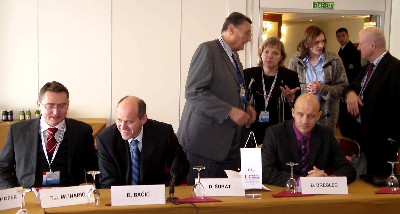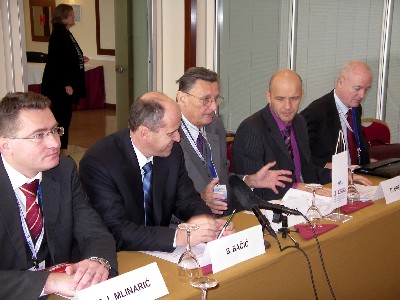


 The first international conference on intermodal transport in southeast Europe under the name ' Adriatic ports – Adriatic Gate of Europe', attended by 200 experts from seven European countries and representatives of the European Commission and international financial institutions, started today with its work in Opatija (24-25 November).
The first international conference on intermodal transport in southeast Europe under the name ' Adriatic ports – Adriatic Gate of Europe', attended by 200 experts from seven European countries and representatives of the European Commission and international financial institutions, started today with its work in Opatija (24-25 November).
Intermodal transport is a form of transport combining at least two types of transport in a row, where the larger part is being carried out via the railway, inland waterways or ocean ships. The first and last part, performed via road transport, is expected to be kept as short as possible.
One of the main massages, stated at the beginning of the meeting, refers to the expectation for Croatia to join as soon as possible the trans-European transport network and to turn the Adriatic ports into the ‘gate’ of Europe. The current link between the Danube River and the Adriatic Sea is not satisfying and the participants of the meeting will try to find a solution to that problem.
Branko Bačić, the State Secretary for Sea, explained at the press-conference that Croatia was working hard to improve the quality of its maritime shipping, its ports, and its inland waterway transport. Amongst other things he announced the beginning of the modernization process of the port of Gruž as well as 85% of the reconstruction works in the port of Rijeka.
Bačić emphasized that, during the past five years, the traffic in ports had increased by a 100%, and that a total of 331 kilometers of new motorway routes had been built.
He continued that in the upcoming four years the river ports of Sisak, Slavonski Brod, Karlovaca and Osijek would receive investments up to EUR 100 million.
 'The Ministry of the Sea, Tourism, Transport and Development will support the European policy of the 'White Book' and the policy of redirecting transport from roads onto less expensive modes of transport', concluded Bačić.
'The Ministry of the Sea, Tourism, Transport and Development will support the European policy of the 'White Book' and the policy of redirecting transport from roads onto less expensive modes of transport', concluded Bačić.
This concerns the 2001 European transport policy, i.e. the 'White Book' which stimulates intermodal transport.
The State Secretary for Transport, Dražen Breglec, pointed out that the next step in the development of the Croatian transport policy, after finalizing the necessary traffic routes, would be the development of the inland waterways, maritime and railway infrastructure. This was to be realized with help of the European funds.
Livio Ambrogio, president of the European Intermodal Association (EIA), underlined that there was no need for Croatia to wait; it was possible to start introducing intermodality in form of smaller but also quite important projects and enhancements.
The vice-president of the Steirmark Chamber of trade, Gilbert Frizberg, said that it was necessary to build the 10A transport corridor based on a private – public partnership, accentuating how important it was for Croatian to have good traffic routes from Maribor to Zagreb (via Krapina).
The Conference includes five plenary sessions, discussing EU policy and intermodality, intermodality in southeast Europe, Adriatic ports and the intermodal network between the Danube River and the Adriatic Sea, equipment and industry of intermodal transport as well as the financing of projects for the enlargement of the European transport system towards the Southeast.
The Conference was organized by the Intermodal Promotion Center from Zagreb, EIA- European Intermodal Association, and the Croatian-Austrian Chamber of trade from Graz. (Hina)